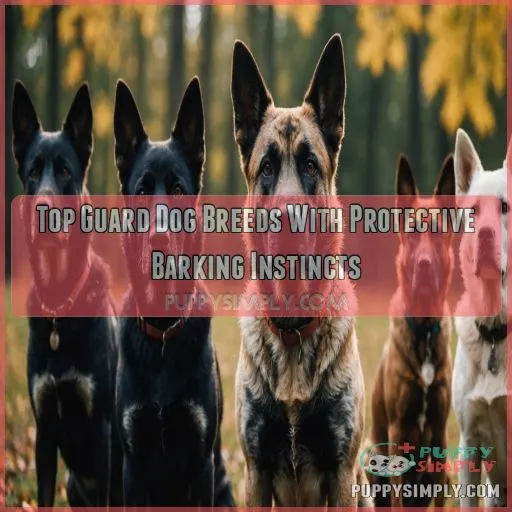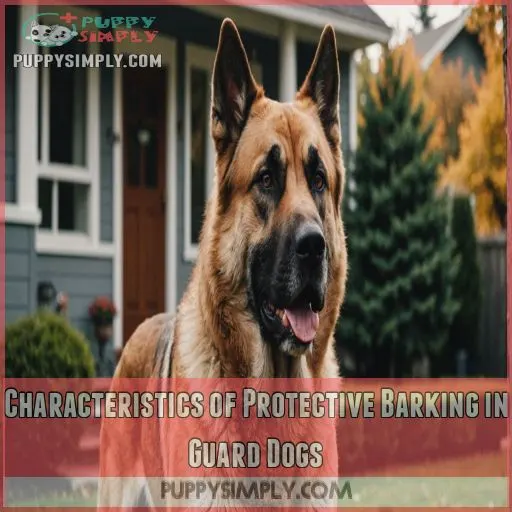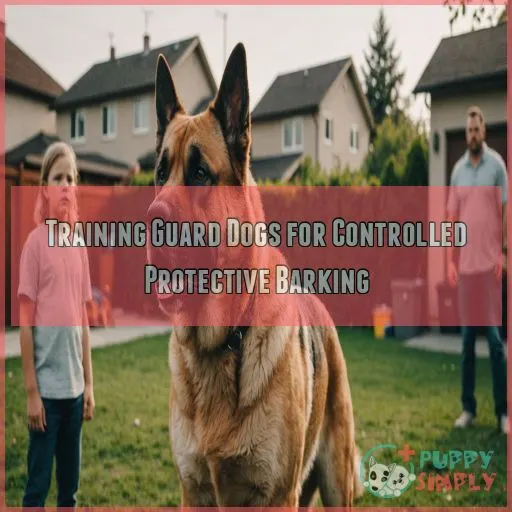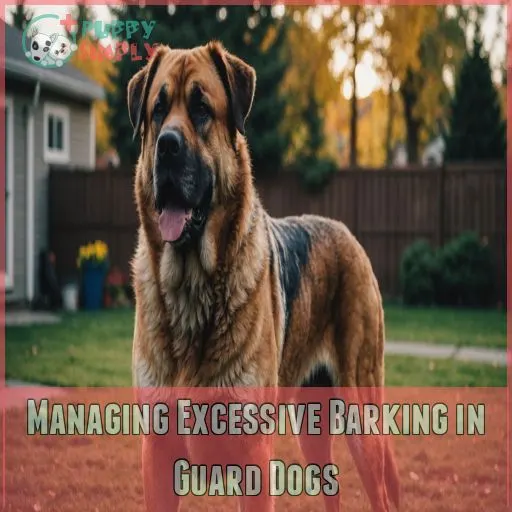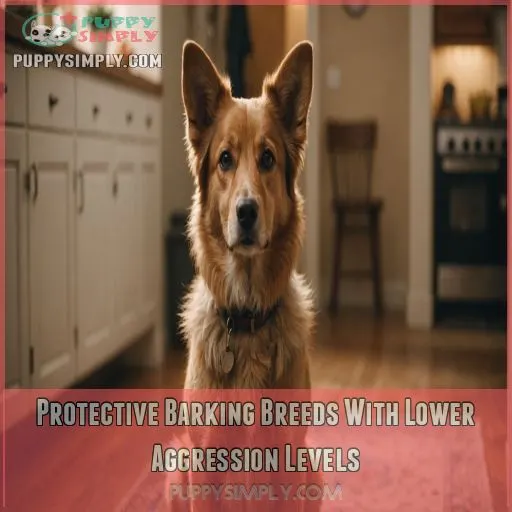This site is supported by our readers. We may earn a commission, at no cost to you, if you purchase through links.
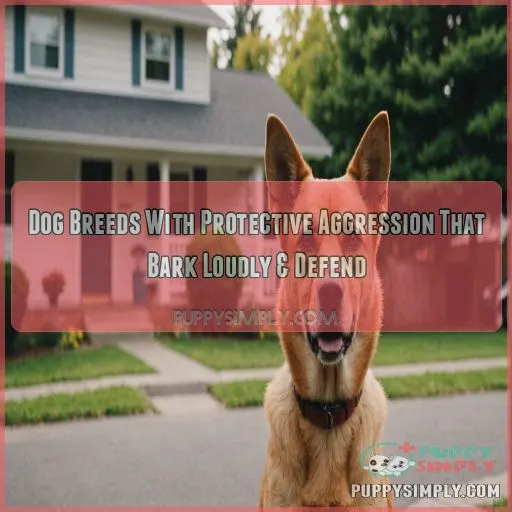
Rottweilers, with their powerful build, make formidable protectors, while the belgian malinois offers a feisty bark and sharp instincts.
These breeds won’t just guard your home—they’ll make intruders think twice!
Ever seen a Giant Schnauzer in action? It’s like having a gentle giant with a lion’s roar.
So, if you’re after a blend of might and loyalty, you’re in the right kennel.
But what about smaller guardians? Let’s fetch that next!
Table Of Contents
- Key Takeaways
- Top Guard Dog Breeds With Protective Barking Instincts
- Characteristics of Protective Barking in Guard Dogs
- Training Guard Dogs for Controlled Protective Barking
- Small to Medium-Sized Protective Barking Breeds
- Large Guard Dog Breeds Known for Barking
- Health Considerations for Protective Barking Breeds
- Legal Aspects of Owning Protective Barking Dogs
- Comparing Protective Barking Breeds for Different Environments
- Managing Excessive Barking in Guard Dogs
- Protective Barking Breeds With Lower Aggression Levels
- Frequently Asked Questions (FAQs)
- Conclusion
Key Takeaways
- You want a dog that barks like it’s auditioning for a canine opera and protects like a knight? Breeds like german shepherds and Doberman Pinschers can turn heads and guard your place with fierce loyalty and a formidable bark that might just wake the neighbors.
- If you’re concerned with size but still need a bark that says, "Get off my lawn," consider a Miniature Schnauzer or shetland sheepdog. These little guys pack a vocal punch and will defend their turf as if their favorite chew toy is at stake.
- Training is a game of patience, like teaching a squirrel to juggle, but with positive reinforcement, you can fine-tune your dog’s bark to be your trusty security system—and avoid barking marathons during family movie night.
- When it comes to health, remember to keep those vocal cords in check. Making sure your dog gets lots of exercise and the right food will keep them barking healthily without sounding like an old creaky gate.
Top Guard Dog Breeds With Protective Barking Instincts
When looking for a guard dog that barks to alert and defend, consider breeds like German Shepherds, Dobermans, and Rottweilers—they’ve got bark and bite, but thankfully, only when needed.
These dogs, alongside others like the Belgian Malinois and Giant Schnauzer, are experts at keeping unwanted guests on their toes, so you’re sure to feel safe with them around.
German Shepherd
A German Shepherd’s loyalty and intelligence make it a top choice for those seeking a watch dog with protective aggression.
These dogs thrive on training and socialization, channeling their spirited temperament into guarding tasks.
While Shepherd health issues may arise, their history of bravery and commitment keeps their barking—loud and proud—a reassuring anthem of security.
Doberman Pinscher
The Doberman Pinscher is a sleek, powerful guard dog known for its fierce loyalty and protective instincts.
With its imposing stature and loud, deep bark, this breed can be an intimidating presence.
However, with proper training and socialization, Dobermans can be affectionate, intelligent companions.
Just be prepared for their unwavering devotion to their family!
Rottweiler
Thick-coated and formidable, Rottweilers make excellent protective dogs.
Their history as working dogs is part of their DNA, driving their temperament.
Train yours with positivity to channel that protective aggression into watchful loyalty.
Regular socialization sessions can turn your Rottweiler into a loving family guardian, ensuring safety without unnecessary barks.
Belgian Malinois
When you think about the Belgian Malinois, imagine a loyal partner with a fierce bark. They love to work and have protective aggression that makes them excellent guard dogs.
Here’s how they shine:
- Training: Requires rigorous exercises.
- Malinois vs. GSD: More intense energy.
- Health issues: Prone to hip dysplasia.
- Temperament: Sharp as a tack!
Giant Schnauzer
Giant Schnauzers are like the gentle giants of guard dogs, fiercely protective yet lovable. Their loyal temperament makes them great for protection, while their grooming needs keep you busy. Remember, they’re not just for show—training is key! With a history as working dogs, they demand attention to their health.
Giant Schnauzers are loyal and protective dogs that need consistent training like Rottweilers.
| Aspect | Details |
|---|---|
| Temperament | Protective and loyal |
| Grooming | Requires regular trimming |
| Training | Needs consistent training |
| Health | Active, with good nutrition |
Characteristics of Protective Barking in Guard Dogs
As a responsible dog owner, it’s important to understand the unique characteristics of protective barking in guard dog breeds.
From vocalization types to territorial behavior, recognizing these traits can help you train and manage your pup’s natural instincts effectively.
Vocalization Types
Barking patterns in guard dogs can vary like the keys of a piano.
From alarm calls that echo through the house like a personal security system, to growling types that resemble a simmering storm, these vocalization types let you know something’s amiss.
Whining signals might mean they’re unsure, and howling behaviors could liken them to a canine opera.
Body Language
Reading your dog’s body language is like deciphering a secret code.
Notice these clues:
- Tail wags – A fierce wag means business.
- Ear position – Ears perked high show readiness.
- Lip curling – A subtle snarl spells caution.
- Posture changes – Tense muscles indicate alertness.
Combine these signals with a loud bark, and you’ve got a reliable protector!
Territorial Behavior
Guard dogs are like vigilant guards that prioritize boundaries and "stranger danger."
Their territorial behavior is your first line of home defense.
They’re alert, watchful, and loyal, refusing to let any sneaky stranger catch them napping.
These dogs, alongside sturdy fences, help to keep unexpected visitors at bay, making them perfect for families seeking protectors.
Threat Assessment
How do your guard dog’s threat assessment skills help keep your home secure? By carefully analyzing body language, sound discrimination, and visual cues, these canine protectors can intuitively recognize potential dangers and spring into action.
Their heightened environmental awareness makes them the ultimate watchdogs – always alert, yet happy to shower you with affection.
Training Guard Dogs for Controlled Protective Barking
Training your guard dog to bark on command can feel a bit like teaching a squirrel to ride a tiny bicycle—challenging but impressive once mastered!
Positive reinforcement and consistent socialization are key to teaching your furry protector to bark when needed and stay quiet during family movie night.
Positive Reinforcement Techniques
When training your guard dog, think of positive reinforcement techniques as your secret weapon.
Just like kids, these pups thrive on reward systems and treat motivation.
Consistency is key; stick to clicker training for behavior shaping.
Bark on Command
Having your dog bark on command is as handy as a pocket on a shirt.
Start with vocal cues like "speak" to link barking with treats.
Consistent training boosts command reliability and obedience levels.
Keep sessions engaging with positive reinforcement.
Remember, those watchful breeds thrive on clear guidance, making barking training spotlight their alert nature, keeping dog bite prevention top-of-mind.
Quiet on Command
You’ll want to teach your guard dog the "quiet" command to curb excessive barking.
This involves:
- Identifying barking triggers and redirecting their attention.
- Consistently rewarding quiet behavior with treats and praise.
- Introducing alternative commands like "speak" and "hush" to give them an outlet.
With patience and consistency, you can train your watchful pup to be alert yet obedient.
Socialization Strategies
Training your guard dog to respond to "quiet on command" was just the beginning.
Now, let’s tackle socialization strategies, ensuring your furry protector thrives.
Early-age exposure is key—think positive puppy classes, social play, and encounters with friendly faces.
It’s about fear reduction and building confidence.
Many dog breeds that are alert, watchful, and good with children benefit from this approach.
Small to Medium-Sized Protective Barking Breeds
If you’re looking for a small or medium-sized dog that can alert you with its bark and stand ground, consider breeds like the Miniature Schnauzer or Shetland Sheepdog.
These breeds aren’t exactly watchdogs in size, but they sure don’t lack the vocal enthusiasm to defend their turf, even if it’s just the living room couch!
Miniature Schnauzer
We’ve considered training, now let’s discuss the Miniature Schnauzer.
This lively breed boasts a fearless watchful temperament, perfect for alerting you to anything amiss.
With proper training, grooming, and exercise, you’ll find these intelligent, strong dogs are both fun and loyal.
Their alertness is like having a security system on four legs, but remember, they’re total charmers too!
Shetland Sheepdog
The Shetland Sheepdog, often called the "Sheltie," is a small to medium-sized breed known for its protective instincts and watchful nature. These pint-sized pups may be small, but they’re great at guarding their family. With their keen senses, alert barking, and courageous spirit, Shelties make excellent watchdogs for any home.
Personality and Temperament
- Highly intelligent and keen to please
- Loyal, affectionate, and protective of loved ones
- Energetic and require regular exercise and mental stimulation
- Prone to barking, making them excellent early warning systems
- Respond well to positive reinforcement training methods
Kuvasz
Looking for a breed that’s watchful and loyal like the Shetland Sheepdog, but with more size?
Meet the Kuvasz! Known for its courage and protective instincts, this gentle giant has a heart of gold and will safeguard your family.
With proper training and grooming, you’ll gain a devoted companion who’s as alert as a night owl after espresso.
Appenzeller Sennenhund
If the Kuvasz caught your fancy with its guarding prowess, then an Appenzeller Sennenhund might also tickle your interest.
This cheerful breed has a natural watchdog temperament, always on the lookout.
Training them gets you results since they’re smart cookies but require space and activity to thrive.
Their healthy bark will announce visitors like they’re on a VIP list!
Large Guard Dog Breeds Known for Barking
If you’re looking for the loudest barkers in the dog world, you’ll find giants like the Great Pyrenees and the Anatolian Shepherd right at the top.
These big furballs may look cuddly, but they’re your home’s personal alarm system, with barks that can probably be heard from space!
Great Pyrenees
Towering at over 100 pounds, the Great Pyrenees is a majestic guardian with a thick, fluffy coat that demands regular grooming. This gentle giant is fiercely loyal and protective, with a deep, resonant bark that can deter even the bravest intruder.
However, their independent nature means training can be a challenge – but the rewards of owning such a devoted companion are well worth it.
- Impressive size and stature
- Loud, intimidating bark
- Requires extensive grooming
Caucasian Shepherd Dog
The Great Pyrenees is majestic, but perhaps you’re considering a true force of nature—the Caucasian Shepherd Dog.
With a temperament fiercer than a thunderstorm, this dog isn’t for the faint-hearted.
Training challenges abound, and health concerns can loom large.
Yet, in spacious living conditions, they’re guardians and family companions all rolled into one fluffy, barking package.
Anatolian Shepherd
Following the impressive Caucasian Shepherd Dog, let’s talk about Anatolian Shepherds. Known for protective aggression, these powerful dogs boast a booming bark.
Their rich history as guardians shows in their courageous temperament.
Training requires patience; they’re independent thinkers. Grooming’s a breeze, but watch their health. With proper care, they make trustworthy, loyal companions for those seeking security.
Komondor
Looking for a dog breed that’s as bold as its dreadlocked appearance? Meet the Komondor. Known for its protective instincts and loud barking, it’s like having your own fluffy sentinel.
Grooming this courageous and independent breed is a hair-raising adventure! Ideal for rural living, they’re loyal companions with a rich history of guarding livestock.
Perfect for a watchful protector.
Health Considerations for Protective Barking Breeds
As powerful guard dogs, breeds known for protective barking have some unique health needs to keep in mind.
You’ll want to watch out for potential throat and vocal cord issues.
Make sure they get enough exercise and provide a nutritious diet to fuel their big personalities.
Throat and Vocal Cord Issues
When your guard dog’s protective barking could start sounding like a rusty hinge, it might be time to pay attention to potential throat and vocal cord issues. If you’re looking for a breed known for its protective barking you might want to check out the Great Pyrenees, known for their strong protective instinct.
Good news: barking therapy and lifestyle adjustments can help, but some breeds may have predispositions for vocal cord paralysis.
Surgical interventions may be necessary, so consult your vet for options suited to your dog’s needs.
Exercise Requirements
After considering vocal strain, it’s time to ponder exercise intensity.
Guard dogs are brawny and need regular adventures to stay healthy and happy.
Whether it’s daily walks or breed-specific activities, these muscular canines thrive with a time commitment from you.
Keeping them obedient and athletic enhances their protective duties, but it also keeps their spirits high.
Nutritional Needs
Feeding guard dogs with protective aggression isn’t just throwing kibble their way.
You’ll need a balanced diet, featuring high-quality food and supplements, to keep them healthy, obedient, and devoted.
Like a car needs fuel, your dog’s health depends on nutrition.
Legal Aspects of Owning Protective Barking Dogs
As a responsible owner of a protective barking dog, you’ll need to be aware of local laws and regulations.
Breed-specific legislation and noise ordinances are important legal considerations to keep in mind for the safety and well-being of your canine companion.
Breed-Specific Legislation
Dealing with breed-specific bans is as tricky as a squirrel on a power line.
These regulations pose legal challenges, often fueled by public perception rather than facts.
They focus on breeds like Pit Bulls, raising ethical concerns about fairness regarding breed-specific legislation.
Reform these policies by showing your pooch’s friendly and devoted side, even if they’re as stubborn as a mule sometimes!
Noise Ordinances
Owning a vocal protector? Brace yourself, as noise complaints might bark louder than your dog! Familiarize yourself with legal limits, especially barking hours in quiet zones. A friendly chat with neighbors can go a long way. Consider soundproofing your home. With sensitive training, even the most obedient canine can become a calm companion and avoid becoming the neighborhood siren.
Liability Insurance
After taming noise ordinances, let’s chat about liability insurance, your trusty umbrella in a lawsuit storm. It shields you from unexpected pet mishaps like a hero in disguise.
Look for coverage that tackles:
- Pet insurance costs that don’t break the bank
- Claim processing so smooth it feels like magic
- Breed exclusions that play nice
- Coverage limits that match your needs
Stay playful and prepared!
Responsible Ownership Laws
As a responsible dog owner, you’ll want to brush up on local leash laws, noise ordinances, and any breed-specific legislation.
Legal Requirements
Microchipping your pup and getting liability insurance can also give you peace of mind.
Safety and Responsibility
After all, your furry friend’s safety and your community’s wellbeing should be top priorities. With a little preparation, you can make sure a harmonious relationship between your protective pooch and the neighborhood.
Comparing Protective Barking Breeds for Different Environments
Choosing the right protective barking dog breed depends on where you live, whether it’s a busy city, the wide open countryside, your cozy family home, or a high-security commercial property.
You wouldn’t want a Great Pyrenees in a city apartment—unless you like sharing your sofa permanently!
Urban Settings
City streets can feel like a jungle, but your protective barking breed can thrive in urban settings. Here’s the scoop:
- City walks are adventure walks—keep your dog on a short leash and grin at fellow city dwellers.
- Noise complaints? Train them early to bark on command.
- Seek dog-friendly businesses to satisfy their playful side.
Rural Properties
In rural properties, you’ve got to handle brawny and powerful dogs that excel in livestock protection and handling wildlife threats.
Opt for breeds like the Anatolian Shepherd or Great Pyrenees, sensitive and devoted.
They’ll bark to defend property boundaries, but watch for neighborly disputes.
Having a protective companion feels like having a trusty guardian on patrol.
Family Homes
When choosing a guard dog for your family home, look for breeds known for their friendly, playful, and calm demeanors.
Breeds like the Bernese Mountain Dog, Newfoundland, and Old English Sheepdog are sensitive, obedient, and great with kids.
Just be sure to provide proper training and socialization to manage their protective barking instincts.
Commercial Security
After ensuring your family home’s safety, explore brawny, muscular, protective breeds for commercial security.
Imagine these sensitive giants as part of your security system.
Guard dog training helps prevent false alarms and addresses liability concerns.
Though costs can vary, comparing this powerful option with traditional systems highlights their reliability.
Managing Excessive Barking in Guard Dogs
If your guard dog is sounding the alarm a bit too often, you’re not alone—sometimes they think the mailman is an enemy spy!
Tackling excessive barking in these protective breeds requires understanding their instincts while keeping peace in your home, and we’ll explore some practical ways to turn down the volume.
Behavioral Modification Techniques
Got a guard dog barking up a storm? Use positive reinforcement! Reward quiet moments to promote peace.
Desensitization training paired with counter-conditioning can help; it’s like teaching your dog to ignore those pesky squirrels.
If your pup’s as stubborn as a mule or domineering, aversive control can help reduce barks, making them obedient and sensitive companions.
Environmental Enrichment
Environmental enrichment can help curb excessive barking in guard dogs.
Providing your guard dog with safe spaces to play and explore will help.
Mentally stimulating toys and activities will also help.
Make sure your pup gets enough physical and sensory input.
This will keep your pup happy, healthy, and less likely to bark unnecessarily.
Anti-Bark Devices
When your guard dog’s barking drives you up the wall, anti-bark devices can help. Here’s the scoop:
- Effectiveness: Results vary; stubborn pups might need alternatives.
- Types: Collar buzzers, ultrasonic devices, and sprays.
- Side-effects: Some devices may escalate anxiety—watch closely.
Always weigh your pup’s sensitive nature, and legality if you’re considering this route, finding balance like a well-trained border collie.
Professional Training Services
Finding the right professional training services can be easier than herding cats! Explore breed-specific programs and certified trainers who address behavioral issues.
Whether training costs pinch you or you’re searching for a friendly, obedient pup, discover methods making smart dogs sensitive and devoted.
| Feature | Details |
|---|---|
| Training Costs | Varies by program |
| Certified Trainers | Specialized professionals |
| Breed-Specific | Made for your breed |
Enjoy a happier, quieter home!
Protective Barking Breeds With Lower Aggression Levels
If you’re looking for a watchful, barking companion without the high aggression levels, you’re in luck.
Breeds like the Bernese Mountain Dog and Newfoundland are often loud defenders but prefer to keep everyone safe through pure charm and bellowing, rather than bites flying.
Bernese Mountain Dog
The Bernese Mountain Dog is a gentle giant known for its protective instincts and loyal devotion to its family.
They have a deep, booming bark, but their aggression levels are relatively lower compared to other guard dog breeds.
With proper training and socialization, these sensitive pups make wonderful, obedient companions who’ll defend their loved ones without hesitation.
Newfoundland
Newfoundlands are like gentle giants with protective instincts.
They’re devoted pals who love water sports, making bath time a breeze!
Though not high on aggression, their brawny and muscular build offers peace of mind.
Regular grooming keeps that glorious coat shiny.
With a lifespan that warms your heart, they’re the perfect cuddle buddies ready to bark if needed.
Leonberger
Meet the Leonberger – the gentle giant with a bark that commands respect.
This breed blends power with a friendly temperament, making it an ideal protector.
Known for its loyalty and devotion, a Leonberger will guard your castle with a leonine roar.
Regular grooming and consistent training will help your furry friend stay healthy and well-behaved.
They might occasionally drool, consider it canine love!
Old English Sheepdog
Unlike the towering Leonberger, Old English Sheepdogs are fluffy giants with big protective barks and lower aggression levels. Imagine caring for a shaggy marshmallow! You’ll find them:
- Devoted and sensitive, seeking your affection.
- Enthusiastic barkers keeping intruders at bay.
- Temperamental with their notorious grooming needs!
- Obedient yet tricky during training—patience is key.
Ready for the challenge?
Frequently Asked Questions (FAQs)
What are the signs of protective aggression?
Ah, protective pups – they’re a real hoot, aren’t they?
Keep an eye out for those telltale signs, like a stiff posture, intense staring, and a deep, rumbling growl.
With the right training, you can turn that guard dog into a total softie.
How does barking enhance a dogs protective behavior?
Barking serves as a dog’s alarm system, alerting you to potential threats.
Think of it as your furry friend’s way of saying, "Hey, watch out!"
It taps into their protective nature, keeping intruders at bay.
Are there specific commands effective for reducing barking?
To reduce barking, try commands like "Quiet" or "Enough."
They should be used consistently, as consistency is key to effective training.
Use treats for positive reinforcement when your furry pal stops barking.
This consistent training is similar to training a stubborn kite to fly straight in the wind , requiring patience and persistence to achieve the desired results through reinforcement and consistency.
What role does genetics play in barking propensity?
Genetics largely influences barking propensity.
Some breeds are wired to bark more, often for protection or alerting their owners.
Give a dog a bone, and genetics may have already decided if it’ll bark at it!
Can protective barking be beneficial for urban living?
Protective barking from guard dogs can be a real asset for urban living.
Their watchful presence and loud alerts can deter potential intruders, giving you and your family greater peace of mind.
Just be sure to train them responsibly.
Conclusion
Imagine a world where every bark is a balancing act of protection and peace.
If you’re exploring dog breeds with protective aggression that bark, you’ve looked into an intriguing blend of strength and sound.
From the assertive German Shepherd to the mighty Rottweiler, these dogs are more than just noise—they’re committed defenders.
Choose wisely based on living conditions and personal needs, and you’ll find a loyal companion ready to keep both you and your neighborhood safe.

